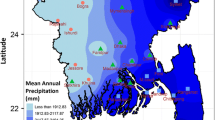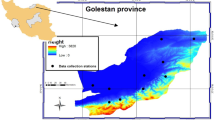Abstract
Contrary to the belief that Peninsular Malaysia experiences wet condition throughout the year, prolonged dry condition has lately become a recurrent phenomenon in this region. As a result, country's agricultural sector and water resources have been under severe constraints from this situation. To get a clearer picture of the dry condition in Peninsular Malaysia, the Standardised Precipitation Index, based on the data of monthly rainfall from 50 stations, is derived. Spatial analysis is used to illustrate the percentage of occurrences of dry and very dry events. To evaluate the potential risk due to the dry conditions, we modelled the joint distribution of severity and duration of dry condition by means of bivariate copula. Several copula models were tested, and the model, which best represents the relationship between severity and duration, is determined using Akaike information criterion. Based on the results, the return period for the drought severity, based on the longest duration of drought at each station, can be estimated. This enables the drought risk to be calculated, thus planning on the measures to minimise the impact of a prolonged drought to the societies, which can be done by the relevant authorities.





Similar content being viewed by others
References
Akaike H (1974) A new look at the statistical model identification. IEEE Trans Automat Contr AC 6:716–722
Bordi I, Fraedrich K, Petitta M, Sutera A (2007) Extreme value analysis of wet and dry periods in Sicily. Theor Appl Climatol 87:61–71. doi:10.1007/s00704-005-0195-3
Cancelliere A, Salas JD (2004) Drought length properties for periodic—stochastic hydrologic data. Water Resour Res 40:W02503. doi:10.1029/2002WR001750
Chung CH, Salas JD (2000) Drought occurrence probabilities and risks of dependent hydrologic processes. J Hydrol Eng 5(3):259–268
De Michele C, Salvadori G (2003) A generalized Pareto intensity-duration model of storm rainfall exploiting 2-copulas. J Geophys Res 108(D2):4067. doi:10.1029/2002JD002534
De Michele C, Salvadori G, Canossi M, Petaccia A, Rosso R (2004) Bivariate statistical approach to check adequacy of dam spillway. J Hydrol Eng ASCE 10(1):50–57
Dracup JA, Lee KS, Paulson EG (1980a) On the definition of droughts. Water Resour Res 16(2):297–302
Dracup JA, Lee KS, Paulson EG (1980b) On the statistical characteristics of drought events. Water Resour Bull 26(5):823–829
Edwards DC, McKee TB (1997) Characteristics of 20th century drought in the United States at multiple time scales. Climatology Rep 97-2. Colorado State University Department of Atmospheric Science Fort Collins Colorado, p 155
Favre AC, El Adlouni S, Perreault L, Thiemonge N, Bobee B (2004) Multivariate hydrological frequency analysis using copulas. Water Resour Res 40:W01101. doi:10.1029/2003WR002456
Fernandez B, Salas JD (1999) Return period and risk of hydrologic events. I: mathematical formulation. J Hydrol Eng 4(4):297–307
Gupta VK, Duckstein L (1975) A stochastic analysis of extreme long droughts. Water Resour Res 11:221–228
Kao SC, Govindaraju RS, Niyogi D (2009) A spatio-temporal drought analysis for the midwestern US. In: Proceedings of World Environmental and Water Resources Congress, Great Rivers, pp 4654–4663
Kendall DR, Dracup JA (1992) On the generation of drought events using an alternating renewal–reward model. Stoch Hydrol Hydraul 6(1):55–68
Mathier L, Perreault L, Bobe B, Ashkar F (1992) The use of geometric and gamma-related distributions for frequency analysis of water deficit. Stoch Hydrol Hydraul 6(4):239–254
McKee TB, Doesken NJ, Kleist J (1993) The relationship of drought frequency and duration to time scales. In: Proceedings of the 8th Conference on Applied Climatology, California, pp 179–184
Sen PK (1968) Estimates of the regression coefficient based on Kendall's tau. J Am Stat Assoc 63:1379–1389
Serinaldi F, Bonaccoroso B, Cancelliere A, Grimaldi S (2009) Probabilistic characterization of drought properties through copulas. Phys Chem Earth Parts A/B/C 34(10–12):596–605
Shiau JT (2006) Fitting drought duration and severity with two-dimensional copulas. Water Resour Manag 20:795–815
Shiau JT, Shen HW (2001) Recurrence analysis of hydrologic droughts of differing severity. J Water Resour Plan Manag 127(1):30–40
Shiau JT, Feng S, Nadarajah S (2007) Assessment of hydrological droughts for the Yellow River, China, using copulas. Hydrol Process 21:2157–2163
Sklar K (1959) Fonctions de repartition `a n dimensions et leura marges (Distribution functions with n dimensions and margins Leura). Publications de l'Institut de Statistique de L'Universit´e de Paris 8:229–231
Song S, Singh VP (2010a) Frequency analysis of droughts using the Plackett copula and parameter estimation by genetic algorithm. Stoch Environ Res Risk Assess 24:783–805. doi:10.1007/s00477-010-0364-5
Song S, Singh VP (2010b) Meta-elliptical copulas for drought frequency analysis of periodic hydrologic data. Stoch Environ Res Risk Assess 24:425–444. doi:10.1007/s00477-009-0331-1
Suhaila J, Deni SM, Jemain AA (2008) Revised spatial weighting methods for estimation of missing rainfall data. Asia-Pacific J Atmos Sci 44(2):93–104
Tallaksen LM, Madsen H, Clausen B (1997) On the definition and modeling of stream drought duration and deficit volume. Hydrol Sci J 42(1):15–33
Wijngaard JB, Klein Tank AMG, Können GP (2003) Homogeneity of 20th century European daily temperature and precipitation series. Int J Climatol 23:679–692
Wong G, Lambert MF, Leonard M, Metcalfe AV (2010) Drought analysis using trivariate copulas conditional on climatic states. J Hydrol Eng 15(2):129–141
Yue S (2000) Joint probability distribution of annual maximum storm peaks and amounts as represented by daily rainfalls. Hydroscience J 45(2):315–326
Zelenhastic E, Salvai A (1987) A method of streamflow drought analysis. Water Resour Res 23(1):156–168
Acknowledgments
The authors are indebted to the staff of the Malaysia Meteorology Department and the Department of Irrigation and Drainage for providing daily rainfall data to make this paper possible. This research would not have been possible without the sponsorship from Universiti Kebangsaan Malaysia and Ministry of Higher Education, Malaysia. This research is funded under grant number UKM-GGPM-PI-028-2011.
Author information
Authors and Affiliations
Corresponding author
Rights and permissions
About this article
Cite this article
Zin, W.Z.W., Jemain, A.A. & Ibrahim, K. Analysis of drought condition and risk in Peninsular Malaysia using Standardised Precipitation Index. Theor Appl Climatol 111, 559–568 (2013). https://doi.org/10.1007/s00704-012-0682-2
Received:
Accepted:
Published:
Issue Date:
DOI: https://doi.org/10.1007/s00704-012-0682-2




